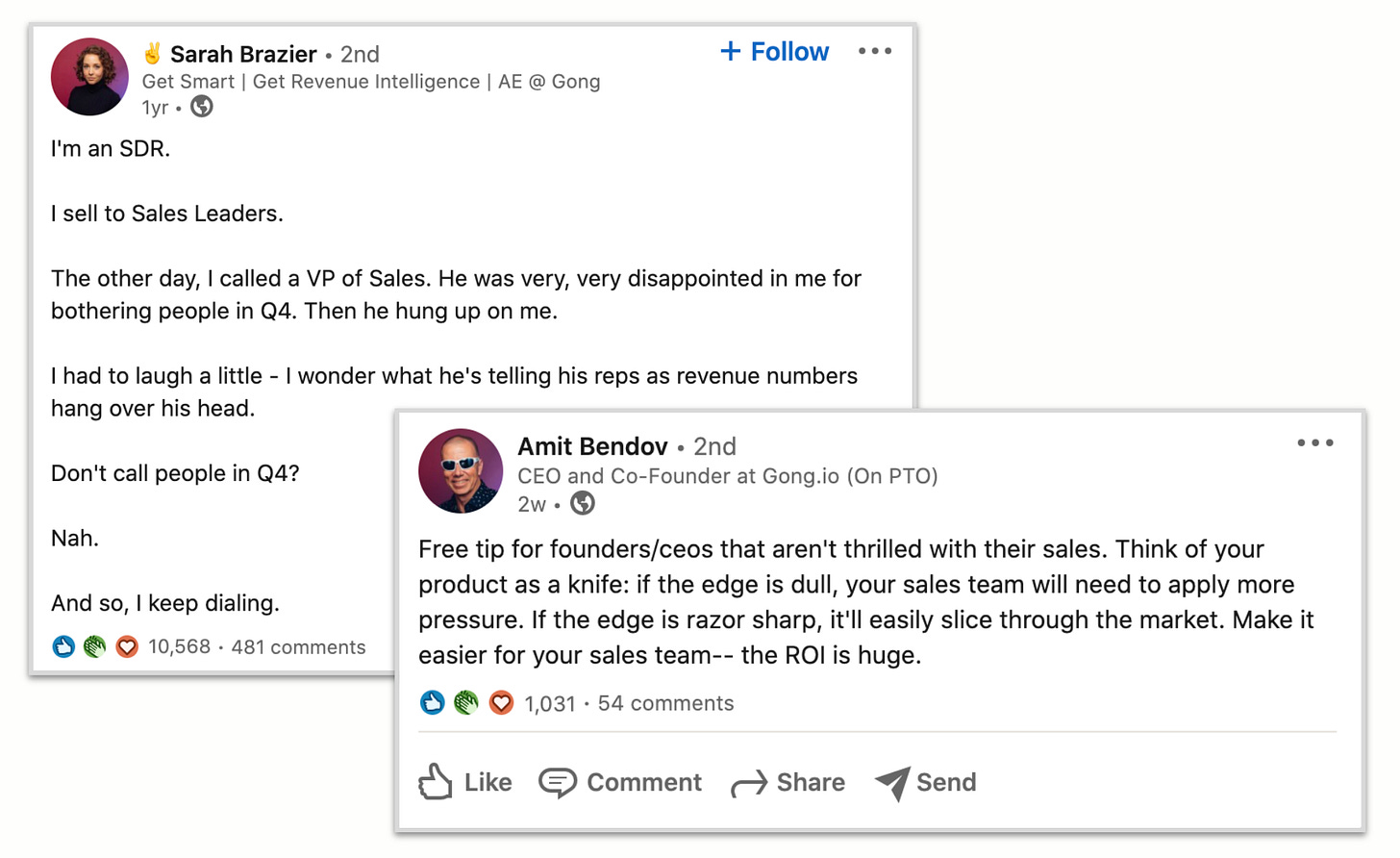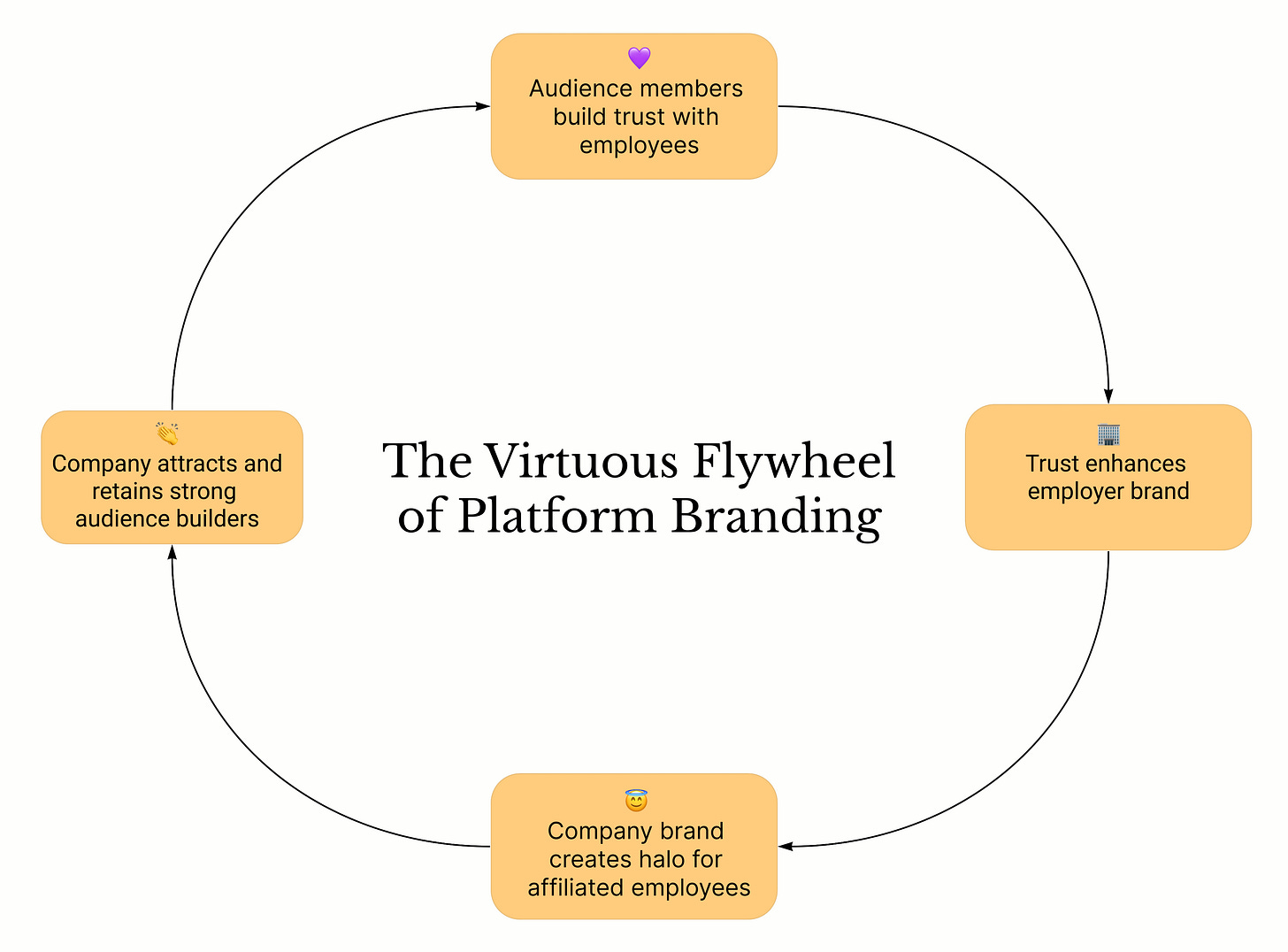The Rise of Platform Brands
Why companies are leveraging their employees to build audiences

This post was originally published in The Jungle Gym.
The War for Attention
Attention is like oxygen for brands. Those that capture it get a chance at life, while those that can’t wither and die.
In the age of mass media, companies only needed to compete with one another to win attention. Ad space on TV, radio, and print was only affordable for deep-pocketed corporations. Individuals, meanwhile, rarely had the means to outbid companies to get noticed.
Social media turned that dynamic on its head. Once Facebook, Twitter, and Instagram allowed people to compete with organizations for airtime, individuals started winning the war for attention.
What gives individuals the clear advantage?
Humans are predisposed to pay attention to one another. From an evolutionary perspective, this feature of our behavior has allowed us to:
- Gather critical information about the dominance and prestige of other group members
- Evaluate our own status and abilities in comparison to others
- Mimic and learn from prestigious members of our ingroup
Of course, this aspect of human nature has not gone unnoticed by brands. Companies have long sought the endorsements of Hollywood stars and, more recently, social media influencers. However, as consumers have gotten used to paid recommendations, high-profile spokespeople have started to lose their credibility.
Instead of leveraging outsiders to build their brands, a crop of forward-thinking companies have started partnering with a new set of stakeholders: their own employees.
In the words of Morning Brew co-founder Alex Lieberman:
Every employee at Morning brew should be a “digital personality” (if they choose).
Traditionally, personal branding is reserved for talent (at media companies) and c-suite execs.
I believe this is a mistake
We live in the age of the internet, which means three things:
- It has never been easier to be a content creator. Internet = free tools
- Technology’s depersonalization has amplified humans’ desire for connection
- Status on social platforms is a new form of personal achievementAll of this creates a tailwind for empowering employees to be creators
It is the company’s responsibility to provide the tools, training, and culture to support this.
And if done properly, it is a win-win for the company & employee
Companies like Morning Brew recognize that consumers want to engage with ideas from individuals rather than faceless companies. Rather than building brands solely through corporate channels, these companies give employees the permission and infrastructure to build affinity with customers on the company’s behalf.
Rather than just building traditional direct-to-customer brands, these organizations are creating platform brands.
How Platform Branding Works

Platform Branding is far less predictable than traditional marketing strategies like paid advertising or SEO. In practice, it has more in common with startup investing. Companies may have lots of employees who are motivated to build audiences. But only some will have the right persona and skillset to engage the type of customers their company is trying to reach.
Individuals who can engage their company’s customers can serve as powerful demand generation channels. But they must use the right approach. Those who only share company blog posts and press releases will struggle to retain followers. To engage a discerning audience, employees must share high-quality content that rivals the best creators on their chosen platform.
Take revenue intelligence startup, Gong. Instead of confining its audience-building efforts to corporate social accounts, Gong has an army of salespeople who are highly active on Linkedin. From the CEO to individual sellers, everyone at the company works tirelessly to get the company’s name in front of prospects.

Notice that neither of these posts explicitly promotes the company or its products. Instead, they are designed to help Gong’s people build followings that will ultimately lead to sales meetings and closed deals.
It is through the transitive property of trust that companies and employees can share audience members. Once an employee builds a trusted relationship with an audience, their followers are more inclined to trust the individual’s employer. After all, the choice of where to work is not a decision most people take lightly. When an impressive person shows their dedication to a company, it signals to audience members that the employer must be impressive as well.
As the brand gains prestige through its public-facing employees, it can distribute the status back to its employees in the form of a virtuous cycle. This is the magic of a strong platform brand.

Ecommerce startup, Fast, used this strategy to rapidly build recognition by partnering with talented audience-builders like their Director of Content, Matthew Kobach.
Not only is Kobach a talented content creator, he also brings with him a large and engaged following of marketers (some subset of which are a good fit for Fast’s solution).

As Fast's star has risen so has Kobach’s, along with every other employee who is publicly affiliated with the company. Fast’s increased prestige will make it easier for the company to get other audience-builders to join them with a pitch that sounds something like:
“Come help us build our audience, and we’ll make sure to build yours as well.”
Perhaps the best example of this kind of partnership is On Deck. Having built a sizable audience of his own through podcasting, On Deck’s Co-founder, Erik Torenberg innately understands what it takes to build a large audience.

To recruit talented leaders for On Deck’s fellowships, Torenberg empowers them to serve as the faces of their respective fellowships and provides ample opportunities to build their public personas.
By attracting and cultivating strong audience builders, companies like Morning Brew, Gong, On Deck, and Fast have increased the surface area of their brands. This, in turn, helps them gain prestige that they can use to retain audience-builders and attract new ones– setting in motion the virtuous flywheel of platform branding.
Passive vs. Intentional Platform Branding
In a certain sense, any company with employees engaged in audience building could shift a traditional brand into a platform. For example, Alexis Gay was hired in a Partnerships role at Patreon in 2018, with Twitter followers numbering in the hundreds. According to Linkedin, she recently left the company with ~82,000 followers after her TikTok takedowns of tech culture exploded.
An example of more intentional coordination can be found with Humu’s hiring of Liz Fosslien. Liz’s book No Hard Feelings directly aligns with the type of problem that Humu’s product is attempting to solve. While Liz wrote the book before joining Humu, the company has been quite supportive as she’s promoted it.
Basecamp offers an example of even tighter coordination. The company teamed up with Head of Product Strategy, Ryan Singer, to launch a co-branded book called Shape Up. The book, which explains Basecamp’s approach to shipping software, has been promoted by the company and its founders.

Any company with employees working on side projects could naturally start resembling a platform brand. What makes the difference is whether the company intentionally coordinates with its people to maximize value.
✓
The Origin of Platform Branding Tactics
The tactics behind platform branding are not entirely new. Many were pioneered by industries whose bottom-line depends on customers viewing their talent as a differentiator. For example:
- VC firms (Sequoia, A16Z, etc.) elevate individual partners to demonstrate the quality of advice that founders can expect when taking their money.
- Consulting firms (Bain, McKinsey, etc.) market their consultants' credentials and expertise to convince companies that they possess special insight that can’t be found elsewhere.
- News organizations (The NY Times, The Wall Street Journal, etc.) have the infrastructure to promote individual journalists to develop a more loyal readership.
In each of these industries, talent is not interchangeable. It makes a difference whether a startup is getting an investment from Marc Andressen or an opinion column was written by David Brooks. To demonstrate the difficulty of getting that value elsewhere, these organizations enhance the reputations of their superstars by:
- Giving employees leverage (in the form of resources, labor, and expertise) to build their personal brands
- Granting them explicit permission to spend time creating and sharing content during work hours
- Featuring employees in company content and promoting them through corporate channels
These tactics allow companies to position their talent as indispensable features of their offering.
While these practices are standard in companies that sell professional services, firms that sell products have traditionally been less enthusiastic about publicly promoting their talent. Rather than advertising individual employees who might demand raises or get poached by competitors, product firms often prefer to market the value their products provide.
But talent publicity and platform branding have an important difference. While the former is done to demonstrate the value a firm has to offer, the latter is all about leveraging employees to grow the company’s reach.
Like any promising development in marketing, it’s worth examining what has changed to make platform branding a more viable strategy.
The Democratization of Influence
Audience building used to be a rarified skillset. Those who were successful at it typically possessed:
- Enough consistent insight to come up with compelling ideas
- Copywriting, design, and production ability to turn their ideas into compelling content
- Marketing expertise to distribute their content across multiple platforms
- Compelling personality traits to build affinity with a large audience
Successful audience builders often monetized their abilities by becoming professional influencers and monetizing their audiences through paid deals with brands.
While some of these abilities are still rare, they have recently become much more democratized thanks to an ecosystem of:
- Online courses like Visualize Value, Write of Passage, and The Part-Time YouTuber Academy offering best practices around content creation.
- No-code creator tools like Substack, Canva, and Descript making content creation much easier
- Online communities like On Deck and Compound training and motivating the next generation of creators
Not only is it easier to become a creator and join the passion economy, but the rewards are more tempting than ever.
Social media is filled with stories of successful individuals quitting their jobs and replacing their income as content creators. This has inspired more individuals to cultivate skills to build audiences.
But, as more people build the basic skills to participate in the creator ecosystem, it has become increasingly difficult to cut through the noise and get noticed. To stand out, individuals are increasingly seeking to associate themselves with prestigious brands with the financial resources to help them stand out.
Together, these factors have made it easier for companies to find employees with the skills and motivation to build large audiences.
While this is likely a good arrangement for companies, what are employees actually getting out of it?
Audiences are the new career moat
In his book So Good They Can't Ignore You, author Cal Newport suggests that the path to permanent employability is to build a portfolio of rare and valuable skills. The right skills, he suggests, will ensure a worker can grow their career no matter what the economy may bring.
While this advice has merit, it begs the question– which skills are truly resistant to technological commodification? If a skill is both rare and valuable, it follows that there must be an incentive for entrepreneurs to attempt to automate it with software.
If skills can no longer provide career security, what can?
Platform branding may provide a clue.
Rather than building skill-based career moats, workers of the future may be using their audiences to secure permanent employment.
If this turns out to be the dominant strategy, many younger workers will start looking for opportunities that enable them to grow their following.
While some individuals will still want to build audiences on their own, many will opt to gain legitimacy and investment by partnering with an employer who can help them grow their reach and status.
Talent Strategy for Platform Brands
Of course, it’s easy to imagine where things might go wrong. A pushy founder could pressure his team to spam their social networks with company content. Or an employee could jump ship for a competitor after a company invests in building her following.
While these are legitimate risks, many can be mitigated through a thoughtful talent strategy. Here are a few principles to keep in mind:
- Honor your employees’ long-term goals – Your audience-building employees likely have larger aspirations than their current role at your company. Make sure you are aware of their objectives and structure the partnership so both parties are building audiences that set them up to accomplish their long-term goals.
- The CEO should take the lead – Employees take cues from the top. When a CEO is blogging or Tweeting every day, it permits employees to do the same. If it isn’t something the CEO is willing to do, employees may fear that they will be perceived as slackers within the organization.
- Employ a portfolio approach – Rather than investing all your eggs in one individual, build the infrastructure to take a portfolio of bets on a diverse group of trustworthy employees.
- Maintain cultural competence – Cultural morays are changing faster than ever. Perspectives that were unobjectionable yesterday can cause a firestorm today. While courting controversy may be part of the plan, make sure employees have the guidance they need to avoid stumbling into hornets’ nests.
- Avoid over-regulation – On the other hand, passing every Tweet through legal can ruin the authenticity and kill the magic. Keep employees informed about what topics they should avoid, but try not to be too heavy-handed.
- Don’t make audience building the only way to get ahead – You will have plenty of employees who do not want to engage on social media or prefer to keep their audiences separate from work. Respect this choice and allow them to get ahead at work by kicking ass at their jobs.
As employees take a larger role in speaking to prospective customers, the line between external brand and internal culture will only blur. Companies that can build attractive cultures that retain top talent are likely to have the most success leveraging their employees to grow the next generation of iconic platform brands.
